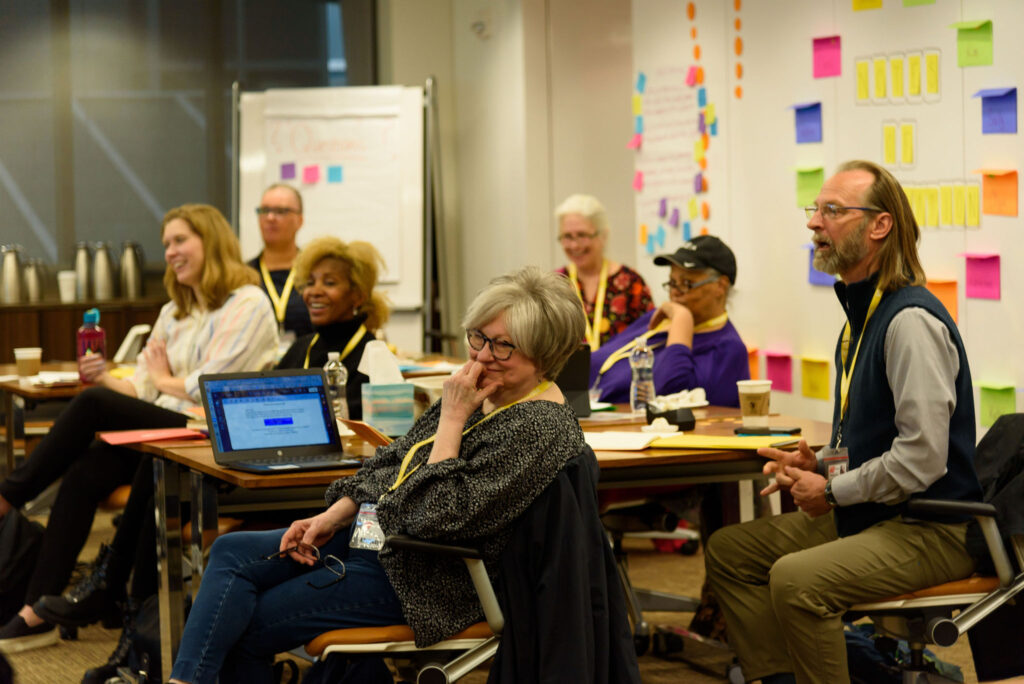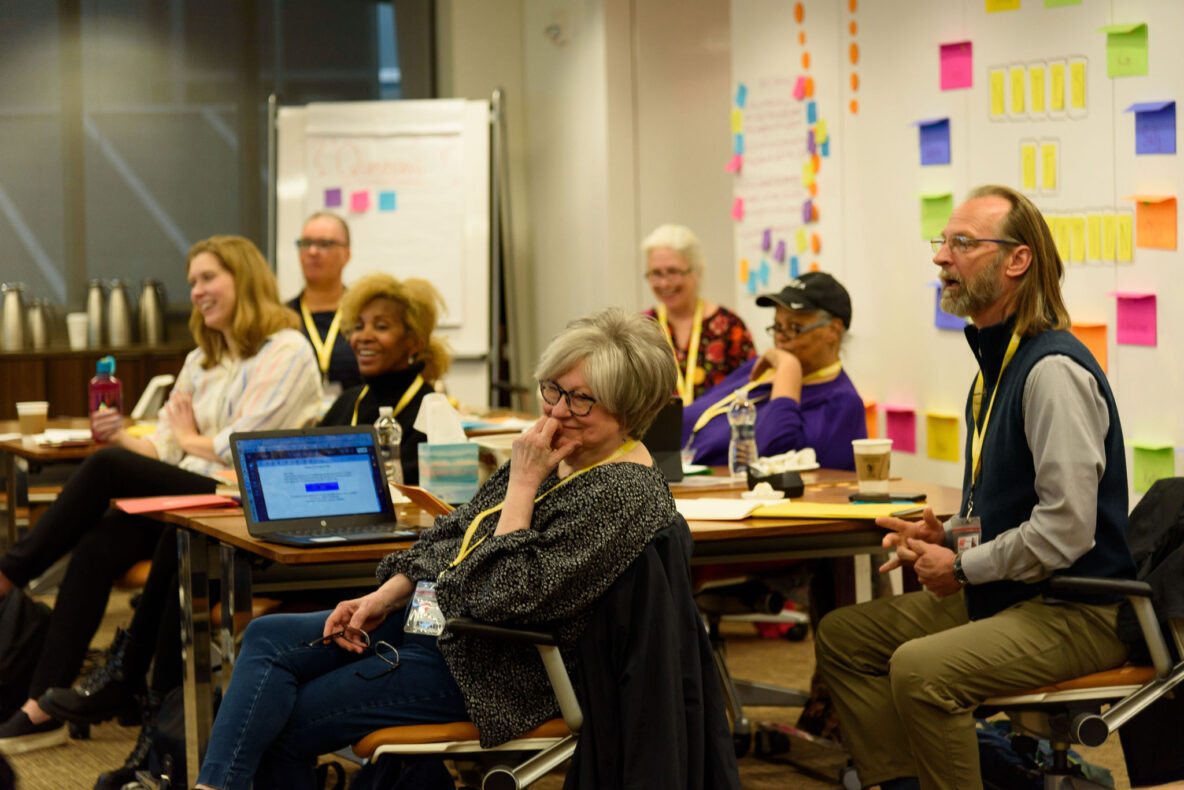
Defector Media workers get together for a December 2024 holiday party. Photo by Arin Sang-urai
By Mark Glaser
In 2019, when workers at sports site Deadspin were upset with its private equity owners and management control over its editorial direction, they quit and, in 2020, struck out to start Defector Media, a worker-owned cooperative. More recently, when public media station WAMU shut down DCist in 2024, a group of laid-off workers started The 51st, eventually becoming a worker-led nonprofit.
Can worker-led, worker-owned cooperatives and nonprofits perform well for newsrooms? These sites are proving the case, and that’s led to a collaborative effort by Start.coop, Defector Media, the Media Economies Design Lab at the University of Colorado, the Freelance Solidarity Project and National Writers Union to start a shared services hub to support nascent worker-led cooperatives. The project was recently funded with a $1.5 million grant from Press Forward’s Open Call for Infrastructure.
Start.coop has deep experience scaling cooperative ownership in other industries such as bicycle stores, craft breweries and artisans. Greg Brodsky, executive director of Start.coop, says that board member Nathan Schneider at the Media Economies Design Lab had been researching cooperatives in journalism and had been studying Defector Media.
Plus, Brodsky and his brother Jeff were both editors of their high school newspaper in New Hampshire, with Jeff later becoming a television producer and media researcher. After Jeff died in 2023, Greg and their father Howard Brodsky set up two award programs in his honor in journalism, one for high school journalism in New Hampshire, and another for oral history through Columbia University, where Jeff got a master’s degree.
“Because of my brother and that background in journalism, when Nathan and Jasper Wang [at Defector Media] proposed a shared service solution to address what the media sector was going through, yes, I was excited about the co-op side, but I had this personal passion because of my family history,” Greg Brodsky said.
The Defector Model
Jasper Wang, vice president of revenue and operations at Defector, said that he came to media by happenstance, being a management consultant for Bain & Company and having done a little work on worker co-ops related to home cleaning services in New York during his MBA studies. He linked up with the co-founders of Defector when they were starting up and realized there wasn’t a lot of investment money for media companies in 2020 during the pandemic.
Wang said they decided to run it as a worker cooperative. “The co-founders already had a documented history of covering sports with a labor-friendly lens,” he said. “We muddled our way through it and wrote our own by-laws. Very quickly after setting it up, we got inbound interest from groups of people in media who wanted to know more about this model.”
One of the goals for Defector was to shield the company and future employees from interference from private equity ownership, so the cooperative model was the solution. The company also practices radical transparency with annual reports like this one from last year that details income and expenses, including Taco Bell receipts, along with detailed commentary on what’s working and not.
Creating a Shared Services Hub for Local News
So how can the project help more cooperative newsrooms succeed using the Defector model? Start.coop already runs regular accelerator cohorts of co-op founders in different sectors. Before they run their first cohort for media companies, they want to have infrastructure in place for the cohort companies to be financially sustainable. Thus the team mapped out the vision for a shared services cooperative on the back end to help the companies save time and money with legal, HR, bookkeeping and other operational activities.

Participants in Start.coop’s cohort kick-off week in Washington, D.C. in 2023. Photo by India Kea
“Setting up a shared service co-op on the back end first will take a lot of initial time and effort,” Brodsky said. “But we think the odds are much higher that when we start to run these cohorts of worker-friendly media companies, they’ll be able to access the shared services and hit the ground running in a more efficient way to leverage these services, save time and increase their profitability.”
In order to create much needed economies of scale and increase the group’s purchasing power, the shared services co-op will not restrict access to just worker cooperatives, but will instead make their services available to any other like-minded worker-friendly newsrooms, whether structured as nonprofits or LLCs. The goal is to build a community of likeminded newsrooms interested in aggregating scale, as well as developing relationships with trusted service providers.
“We are interested in rallying the service providers, the platforms and software who would be interested in joining the hub,” Wang said. “It could be, for example, a lawyer who is inherently interested in cooperative stuff, but hasn’t found an entryway. Or it could be platforms that are interested in offering negotiated rates, if we can bring them more clients.”
Brodsky adds that the goal is to ease the path for newsrooms who want a worker-friendly model, giving them the service providers and best practices they need to succeed, improve profitability and ultimately become more sustainable.
Benefits of the Co-op Model
With the rise of corporate and private equity ownership of local media outlets, and the resulting “ghost newspapers,” it’s no surprise that there’s been a corresponding move toward worker-friendly models such as cooperatives. I asked Brodsky and Wang to list some of the benefits of the cooperative model. They include:
- Companies don’t have to worry about prioritizing profits for shareholders. Instead, the power and income goes to the workers. Brodsky notes that if there are surplus profits, it can go to the workers, and helps build wealth generation for them.
- Journalists start to think like owners and businesspeople. They get more power, but also more responsibility. “I think that actually makes them more responsible journalists and more responsible stewards for the industry of journalism,” Wang said.
- Journalists get a seat at the table and a stake in the larger system. As co-owners of the company, journalists get to vote on management issues and have a say in the company’s strategic direction. Even more importantly, they have agency to make a difference in a systemic way. “Nobody wants to feel they’re just a cog in the machine; when you become an owner, you’re not just a worker for corporate media, you’ve got agency.” Wang said. “I think that’s such an interesting way of thinking, for workers to elevate their view and their role in the process.”
With this ambitious project leading the way, with a shared services hub, more worker-friendly newsrooms will have the chance to offer journalists a seat at the table and the chance for long-term sustainability in serving their communities.
Mark Glaser is a communications consultant for Press Forward, Knight Foundation and Tiny News Collective and was the founder and executive editor of MediaShift.org. He was formerly the director of business and program development for the New Mexico Local News Fund. He runs the Wind Power Media consultancy out of Santa Fe.

